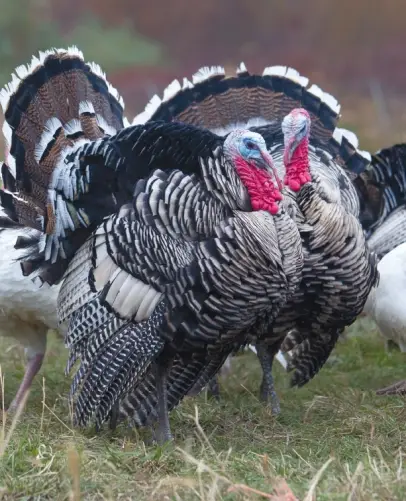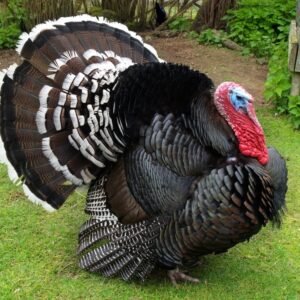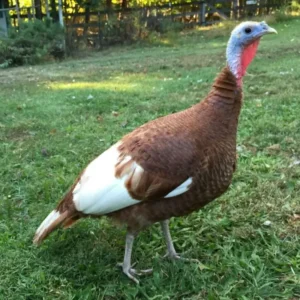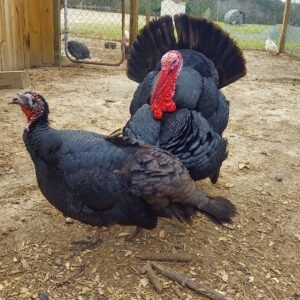$35.00
The Standard Bronze (or Bronze) is a heritage turkey breed characterized by its iridescent bronze-like plumage and primarily raised for meat production . Originating from crosses of European domestic turkeys and eastern wild turkeys, it was standardized and recognized by the American Poultry Association in 1874 . Standard Bronzes are medium-large birds with toms averaging 25–36 lb and hens 16–20 lb, displaying dark bronze feathers tipped with black bands and white flight and tail feathers . They are naturally mating, hardy, slow-growing, and excellent foragers, with modest egg production (20–50 cream-to-brown speckled eggs per year) and good maternal instincts . Once the most popular turkey variety in American history, they are now listed as “Watch” on The Livestock Conservancy’s conservation priority list and remain available through dedicated heritage breeders and hatcheries .
Breed Overview
The Standard Bronze, often simply called the Bronze, is a breed of domestic turkey known for its distinctive iridescent bronze-like sheen across the body plumage . This heritage variety is primarily raised for meat, with birds too large to fly sustained in free-range and pasture-based systems . It retains traditional traits of natural mating, long lifespan, and slow growth compared to industrial breeds .
History & Recognition
Heritage Bronze turkey strains trace back to the early 19th century when domestic turkeys brought by European colonists were crossed with eastern wild turkeys in North America . Bronze-type turkeys existed by the late 1700s, but the name “Bronze” became standardized around the 1830s, with the variety formally recognized by the American Poultry Association in 1874 . Throughout the 1800s, breeders periodically crossed the Bronze back to wild turkeys to enhance vigor, resulting in the most popular turkey variety in American history well into the early 20th century . Commercial selection in the early 20th century gave rise to the Broad Breasted Bronze, which ultimately supplanted the Standard Bronze for industrial production due to faster growth and breast meat yield .
Physical Characteristics
- Plumage: Dark brown to blackish body feathers with a lustrous metallic sheen that glints copper, gold, green, and purple under sunlight .
- Feather Pattern: Flight feathers are barred in white and black, while tail feathers feature a broad bronze band edged by narrow black and white bands .
- Bare Skin: Head, throat, and wattles vary in color—from white to blue, pink, or red—depending on the bird’s emotional state .
- Skin & Beard: Under the glossy plumage the skin is white, and mature toms develop a characteristic black beard .
Size & Weight
According to the APA Standard of Perfection, young toms should weigh approximately 25 lb and young hens around 16 lb, with mature weights rising to 35–38 lb for toms and 18–22 lb for hens . However, many heritage flocks today fall below these weights, often reaching table weight at about 28 weeks due to slower growth selection . Specialist heritage hatcheries report toms in broader ranges of 25–36 lb and hens 16–20 lb, reflecting variability among lines .
Behavior & Utility
Standard Bronzes are active, curious birds best suited to free-range or pasture-based systems where their foraging instinct can be expressed . They are valued for their rich, fine-textured meat and are popular in small-scale and seasonal production . Temperament varies by line—from docile to assertive—depending on breeder selection for show or homestead traits .
Reproduction & Egg Production
Hens lay between 20 and 50 large eggs per year, typically cream to medium brown with light speckling . Eggs average around 2.5 oz (70 g), and hens often maintain productivity for 5–7 years, although most eggs are laid in the first two years . Fertility rates are reported at approximately 60–75% under natural mating, and hens make good setters with strong maternal instincts .
Conservation & Availability
Today, Standard Bronze turkeys are listed as “Watch” by The Livestock Conservancy, reflecting their moderately rare status despite an ongoing resurgence in heritage poultry interest . The FAO’s DAD-IS database recorded 2,656 Standard Bronze turkeys in 2015, while the Standard Poultry Preservation Association census found only 84 toms and 281 hens across eight breeders in 2000 . Breeding stock and poults are available through select heritage hatcheries such as Cackle Hatchery and Murray McMurray Hatchery . Renewed consumer demand for robust genetics, survivability, and superior flavor continues to drive small-flock conservation and breeding programs
Be the first to review “Bronze Heritage Standard Turkey” Cancel reply
Related products
Turkeys
Turkeys
Turkeys
Turkeys






Reviews
There are no reviews yet.